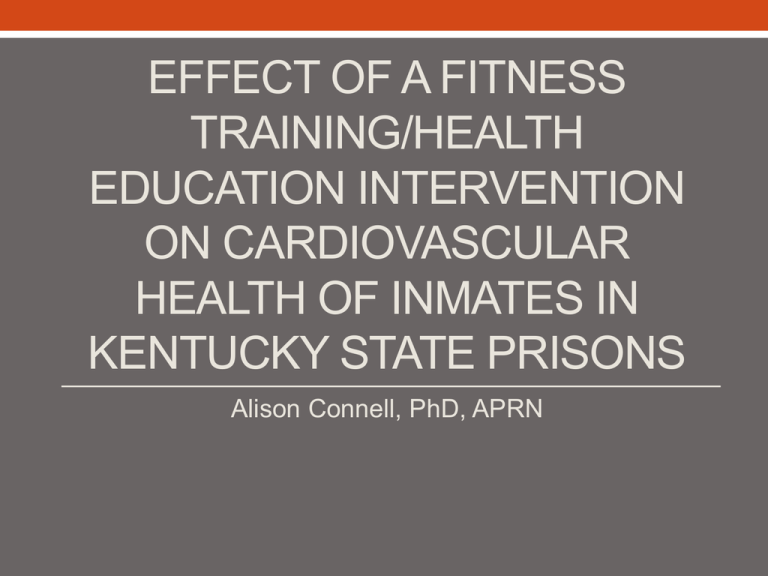
EFFECT OF A FITNESS
TRAINING/HEALTH
EDUCATION INTERVENTION
ON CARDIOVASCULAR
HEALTH OF INMATES IN
KENTUCKY STATE PRISONS
Alison Connell, PhD, APRN
Biobehavioral Cardiovascular
Health Promotion Intervention
In A State Prison System
Debra Moser, DNS, principal investigator
Alison Connell, PhD, co-investigator
Terrie Lennie, PhD, co-investigator
Alison Bailey, MD, co-investigator
Misook Chung, PhD, project director
Funding: National Institutes of Health,
NINR, RC2NR0119428
Background
• Leading cause of death in inmates is cardiovascular
disease
• Adjusted risk of death among recently released inmates
• 3.5 times that of non-incarcerated
• Heart disease is the second most common cause of death in
recently released inmates
• Lower education, income levels and worse health
literacy
• 41 % of inmates in state and federal prisons have not completed
high school or its equivalent, compared to 18.4 % for the nonincarcerated
Wang EA, et al. Arch Intern Med. 2009;169:687-693. van Olphen J, et al. J Urban Health.
2006;83:372-381. Wolff N, et al. Psychiatr Serv. 2002;53:1469-1471.
Binswanger IA, et al. N Engl J Med. 2007;356:157-165. Mumola C. Medical causes of death
in state prisons. www.ojp.usdoj.gov/bjs/pub/pdf/mcdsp04.pdf
Study Purpose and Design
• The long-term objective of the study was to improve the
cardiovascular (CV) health of inmates by implementation
of a state-wide CV risk factor reduction program in prisons
• Specific aim: to determine the effect of a fitness training
and health education intervention on:
• Cardiovascular health as measured by time to 85% of maximal
heart rate using graded exercise treadmill test.
• Self-reported lifestyle behaviors pre- and post-intervention.
Methods
• Four prisons—4 groups in each prison, ~35 inmates per group
• Kentucky State Reformatory
• Luther Luckett Correctional Complex
• Eastern Kentucky Correctional Complex
• Little Sandy Correctional Complex
• Recruited via flyers in dorms and recreation areas
• Data gathered from inmates at four time points
• A multiple baselines design was used in which all participants receive the
intervention, and all have a 3 month run-in period to establish their own
baseline without intervention
• Baseline, pre-intervention, immediately post-intervention and 3 months postintervention
• Intervention—12-week
• Health education with behavior change strategy sessions delivered by
certified health educators—one hour once a week
• Aerobic exercise program led exercise specialists—one hour twice a week
Measures
• Submaximal treadmill test—85% of maximal heart rate
• Modified Bruce protocol
• Inmate Health Risk Assessment—self-report questionnaire
• Exercise
• How often moderate physical activity (0-1, 2-3, 4 or more days a week)
• How often vigorous physical activity (0-1, 2-3, 4 or more days a week)
• Diet
• Usual fruits and vegetables a day (<3, 3-4, 5 or more)
• Usual carbs a day
• Mostly white bread and few grains
• Some carbs from fiber and whole grain
• Mostly whole grain and high fiber
• Usual meat/dairy
• Cheese, whole milk, fried foods 5-7 days a week,
• 2% milk, fried food/chips 3-4 days a week
• No-fat dairy, lean meats, rare fried foods
• Social support
• Stress—how well cope
• Tobacco use—smoke cigarettes every day, some days, not at all
Demographic data of sample
(N = 378)
Age—mean 36.1
Race/Ethnicity
Marital Status
Education level
n
Percent
19 – 30
124
32.8
31 - 45
191
50.5
46 - 77
63
16.7
Caucasian
238
63.0
African American
129
34.1
Other
11
2.9
Single
240
63.5
Married
51
13.5
Separated/Divorced/Widowed
79
20.9
Missing data
8
2.1
Less than high school
76
20.1
High school diploma
148
39.2
Some college
106
28.0
Associate, Bachelors, Masters, PhD or
professional degree
48
12.7
n
Percent
1 - 10 years
72
19.0
11 - 20 years
103
27.2
21 – 30 years
45
11.9
31 years – life
79
20.9
132
34.9
82
21.7
68
18
74
19.6
38
10.1
77
20.4
Length of Sentence and Inmate Offenses
Length of latest sentence—mean 28.4
years
Inmate Offenses
Burglary, theft, robbery, received stolen property, fraud, credit
card theft, forgery
Murder, manslaughter
Sex crimes
Violent crimes, assault, weapons crimes
Trafficking, drug crimes
Other crimes, escape, arson, kidnapping
Intervention Participants
• Total attendance in education and fitness sessions = 36
sessions
• Education 12 sessions
• Fitness 24 sessions
• For analysis divided into tertiles of total attendance
• 0 - 6 sessions
• 7 – 31 sessions
• Over 31 sessions
• Age, education level and length of sentence were
associated with participation.
• There was no difference in intervention participation by
marital status (p = .96) or by self-report of level of health
(p = .79).
Intervention Attendance
• Fewest fitness and education sessions (0-6 sessions)
• 19-34 years old
• Have less than high school, or high school diploma education
• Shorter sentence (less than 20 years)
• Most fitness and education sessions (> 31 sessions)
• Over 35 years
• Over 30 year sentence
Demographic data
0 -6
sessions
7-31
sessions
Over 31
sessions
Х2
df
P
value
Age by quartile
19 - 28
29 – 35
36 - 42
Over 42
39
24
29
26
30
33
18
26
13
28
29
31
16.83
6
.01
Education
< High school
High school diploma
Some college
30
55
23
17
42
37
20
32
28
17.6
6
.007
College degree
10
11
21
1-10 years
35
17
17
12.6
6
.05
11- 20 years
34
38
27
21-30 years
> 30 years
15
21
13
20
15
31
4.7
0.67
8
4
.79
.96
Length of sentence
Health Status
Marital Status
Excellent to poor
Results: Time to 85% of maximal HR
• By third assessment n = 186
• Those who attended more than 31 sessions of the total
education and fitness improved their cardiovascular
fitness as measured by the time to get to 85% of their
maximal heart rate (p = .01)
• When analyzed using just the fitness sessions
• Highest tertile of fitness sessions attended (over 20 sessions)
• (p = .003)
Lifestyle Choices
• Inmate Health Risk Assessment
• Exercise
• How often moderate physical activity (0-1, 2-3, 4 or more days a week)
• How often vigorous physical activity (0-1, 2-3, 4 or more days a week)
• Diet
• Usual fruits and vegetables a day (<3, 3-4, 5 or more)
• Usual carbs a day
• Mostly white bread and few grains
• Some carbs from fiber and whole grain
• Mostly whole grain and high fiber
• Usual meat/dairy
• Cheese, whole milk, fried foods 5-7 days a week,
• 2% milk, fried food/chips 3-4 days a week
• No-fat dairy, lean meats, rare fried foods
• Social ties—no change ( p = .85)
• Stress—no change (p = .28)
• Tobacco use—smoke cigarettes every day, some days, not at all
Self-reported Changes in Behavior
• Exercise
• Inmates with the highest attendance (>31 sessions) reported that they
continued to exercise on non-intervention days
• 26.8% who had been 3 or less days a week at baseline, reported
exercising 4 or more days a week post intervention (p = < .001)
• Diet
• Increasing fruits and vegetables from less than 3 servings a day to over
3 servings a day
• No change in behavior
• Increasing fiber, whole grain from mostly white bread and few whole
grain
• 30.9% of highest intervention group who ate almost all white bread added
fiber through whole wheat or high fiber (p =.04)
• Decreasing fried/fatty foods and drinking 2% milk
• 31.9% of highest intervention group changed from whole milk to 2% and
eating fried or fatty foods from 5-7 d/wk to 4 or less days a week (p = .04)
Cigarette Smoking
• Baseline 39.5% some or every day (N =378)
• 20.2% at KSR—tobacco-free prison (staff and inmates)
• 49.0% at other three prisons—smoking allowed outdoors
• Post-intervention
• 11.5% at KSR
• 41% at other three prisons
• 13 out of 180 (7.2%) who reported smoking “every day” or
“some days” reported smoking "not at all" by end of study
• 8 were in highest attendance group and 5 were in the middle
intervention group (7-31 sessions)
• 9 out of 180 (5%) who reported smoking “not at all” at
baseline, reported smoking every day by 3rd assessment
Conclusion
• Inmates who participated in the most intervention sessions
• Demonstrated improved cardiovascular health as measured by the
time to reach 85% of their maximal heart rate
• Made modifiable lifestyle changes such as
• Increasing exercise
• Decreasing fried foods, whole milk, and increasing fiber in their diets
• Inmates who had longer sentences, over age 35, and more
educated were more likely to participate in the entire
intervention
• Limitations
• Attrition: N = 378 at baseline and n = 180 by the third assessment





